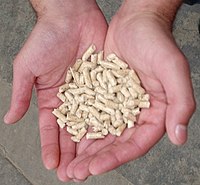
Photo from wikipedia
One of the main products of pyrolysis is char. For the better performance and improvement of its physicochemical properties, it is necessary to make temperature changes. In this study, different… Click to show full abstract
One of the main products of pyrolysis is char. For the better performance and improvement of its physicochemical properties, it is necessary to make temperature changes. In this study, different temperatures have been tested for the pyrolysis of rice husk, and the biochar obtained from the process went through an evaluation to test its yield in the removal of emerging compounds such as azithromycin (AZT) and erythromycin (ERY). For this, pyrolysis of rice husk has been carried out at temperatures of 450, 500, 550, and 600 °C, and the biochars have been characterized by ultimate analysis and proximate analysis, as well as specific surface area tests. Then, different adsorption tests have been carried out with a 200 mg L–1 drug (AZT and ERY) solution prepared in the laboratory. All biochars have been found to present removal percentages higher than 95%. Therefore, obtaining biochar from rice husk at any temperature and using it in the removal of high-molecular-weight compounds are quite suitable.
Journal Title: ACS Omega
Year Published: 2022
Link to full text (if available)
Share on Social Media: Sign Up to like & get
recommendations!